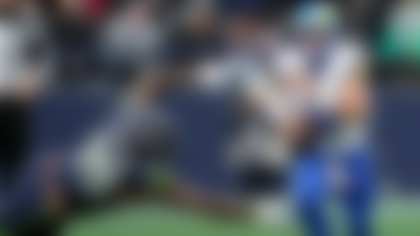Dr. Matthew Matava is the head physician with the St. Louis Rams. He has been with the NFL team for more than 13 years, and last offseason he was elected to a two-year term as the president of the NFL Physicians Society.
Matava specializes in ligament and cartilage injuries, but he also works with Rams regarding all injuries. As NFLPS president, he has helped to move the group forward and is concerned about its relationship with the NFL Players Association.
The St. Louis native talked with NFL Evolution contributing editor Bill Bradley this week about what led him to sports medicine, how the NFLPS will pioneer a review board and how he wants to build a bridge with the NFLPA.
What led you into sports medicine?
Probably the fact that I've always been in sports. I played basketball in college. I tore my ACL in 1983. I had ACL surgery. When I was in medical school, I knew I wanted to be a surgeon, but I wasn't sure what type. After I tore my ACL, I experienced firsthand what it was like to be a patient and I realized it was kind of a neat specialty. Patients for the most part were healthy. They were motivated to get back to activity and it seemed like a natural fit because of my interest in sports. I've played sports all my life in St. Louis, where I grew up. It's a great way to combine medicine with my love of sports and it kind of went from there.
How would you describe your role with the Rams as the team physician?
I'm the head team physician. As the orthopedic surgeon, we deal with injuries to the muscular and skeletal systems, fractures, ligament tears, cartilage injuries and joint and muscle problems. The majority of the injuries we see are orthopedic in nature, although each team has a whole cadre of physicians involved. I have two doctors that help me in orthopedic surgery. The season as you know never really ends. During the season, all games, both home and away. ... Then on Mondays, I meet with players in the training room (and) go over any injuries that we have not picked up during the game. Then on Wednesdays, I go to practice and make sure everybody is good for that. On Fridays, I normally determine who's healthy and decide who is ready for the next game on Sunday. And then we do it all over again. During the offseason, there's the NFL Combine ... where we do about 300 physicals for players who are interested in the draft. That's about a four- or five-day event. Then, (there's) getting ready for the draft and we give each player who is in the draft a grade. Each team grades players differently. But for the most part, it's a grade based on medical severity of their previous injuries. ... Then there's the various mini-camps throughout the year; there's less now than there was before because of the new (Collective Bargaining Agreement). Then there's organized team activities or OTAs and I see players who maybe injured. Then training camp comes around and it starts all over again.
How did you get involved in the NFL Physicians Society?
As a physician in the NFL, you are all but automatically a member. They encourage all of the team (doctors) to join. There's about 177 of (us) now. That number tends to fluctuate every year. ... (Of) all of the major physicians groups -- in the four major sports that is -- I think ours in the NFL is the most academic. I work at Washington University in St. Louis where we educate and we work with students and residents. I really enjoy the camaraderie of the Society. We have a scientific meeting at every NFLPS meeting where we present data and research topics that are pertinent to football players. It's not just the NFL, but it also includes all levels of football. Our group has been very instrumental in doing a lot of research with NFL data that has been published in peer review journals. You start to get to meet the other physicians in the society. You become friends. ... You stay involved and people ask you to become part of a committee or part of the executive committee, which is what I did, and you sort of get elected president.
You "sort of" got elected president?
I think I was the only guy who was willing to do the job (he laughed).
What does the job of president of the NFL Physicians Society entail?
It kind of oversees the whole society. There's various political issues that we deal with. I'm kind of the conduit between the membership and the league itself. ... We changed some protocols this year because the big issue was (putting) the (neutro-trauma specialist) on the sidelines. A lot of what comes from the league has to get translated to the membership. There's usually issues that have to be dealt with. Whenever you tell people how to practice medicine, people are going to rebel to some extent. For the most part, it's a good group to work with. Everybody's primary interest has always been the care of the players. When you keep that in mind, everything sort of takes care of itself. It's a great organization because the people who are involved ... tend to be academically oriented. Just look at the membership. A lot of people are on a major (university) faculty throughout the country and hold various leadership positions through academic societies throughout the country.
How do you get the NFLPS's viewpoints known to the NFL's various committees?
As the physician representative, it's kind of easy to get my point across because some of them are always interested in what a physician's perspective is depending on the topic. For example, the Head, Neck and Spine Committee, their topic the head, neck and spines. It's run by physicians. However, when you go to some of the ownership meetings I go to, often I'm the only physician in the room ... so it's my job to let them know what I think.
What are some of changes going on within the NFLPS?
It starts with the grass-roots level with the teams in terms of medical care. For instance, one of the things we're looking to do in the society is to create a peer review committee. Every hospital or university in the country has a peer review group that goes over all of the patient care issues that were questioned or had complications. It's something we can learn from to try to do better the next time. No other team physician society has that and we're starting that voluntarily on our own. We think it will raise the standard of care in our society. We think the players would appreciate it. The NFLPA would appreciate it. And it's something that's completely distinct and separate from the league. The commissioner doesn't have any say in what we do. We determine what our punishment is if there is any sort of punishment that needs to be handed out on a medical situation. We've been given assurance that the (NFL) will let us run this committee on our own. It's physicians managing and disciplining physicians. That's a new topic that we're trying to get up and running. There's things along those lines that have to be dealt with on a yearly basis.
How has the addition of independent neurosurgeons or neurospecialists to each sideline been accepted by the Physicians Society members?
So far it has worked out great. ... (The neuro-trauma specialists) are there in a supportive role as a consultant should the player have a head injury where it's not quite clear based on his initial examination by the team physician that he truly had a concussion. The (neuro-trauma specialists are) there to examine the patient, evaluate him as he sees fit and weigh in on whether or not the player was injured. The situation where the player has definitely had a concussion and he's out of the game, no questions asked, then the neurosurgeon doesn't even have a role there because it's already been established that the player is not going back into the game. But so far the neurosurgeons have been nothing but collegial. I think we've had a great relationship with them so far. There's been no contentious differences of opinion or anything like that. I think it's worked out great.
The NFL has made concussions the No. 1 injury concern. What are the other injuries the NFLPS has noticed?
It's sort of the opposite (of the head injuries). The players are telling us, "We can't hit each other in the head, so guys are going for the knees to make a tackle." There's a concern sort of brewing that there may be an increased number of injuries to the knee. Players are concerned about hitting too high, now they're hitting lower. Well, in the process you might have a ligament injury and that's happened a couple of times this year. Obviously the players have said to us that they would rather be hit in the head than in the knees. They sort of will take their chances with a concussion, or so they say, but with a knee injury, that could end their career. That's an interesting problem that's starting to develop that the league has started to look at. How do you manage the fact that players have to be fined or penalized if there's a blow to the head, but you can't also go too low and take out their knee as well because it limits their ability to play? It's an interesting topic and something we will have to deal with to some extent.
The other issue is the MRSA infections (reported at the Tampa Bay Buccaneers facility) -- the penicillin resistant staph infection. MRSA is an infection that is prevalent throughout society. We see it a lot in institutionalized patients, those who have compromised immune systems. That usually doesn't speak to our players and their environments. But it is seen in prisons and places where there's close contact between inmates. In a team situation, you have the locker room, the training room where people live and they congregate together in very close contact. St. Louis had an outbreak in 2003 when we had the (Centers for Disease Control and Prevention) come in and analyze how we were sterilizing things, how we were keeping equipment clean and that sort of thing. And we learned a lot from that and we published our findings in the "New England Journal of Medicine." But you always have to keep vigilant. The one thing that occurred because of this MRSA situation (in Tampa Bay) is that players are very cognizant of the fact if they have anything that looks like a boil or a pimple, they let the medical staff know as soon as possible because they don't want it to lead to more than that.
Is there a major goal that you have for the rest of your two-year term president of the NFLPS?
I would like to see the relationship between the physicians and (NFL) Players Association improve. A year ago at the Super Bowl, (NFLPA executive director DeMaurice Smith) made a comment that 78 percent of the players don't trust the team doctors. Yet, none of us have ever seen that survey and any time we ask our players, "Have you taken a survey? What are your thoughts on it?" No player to a team has ever acknowledged that they had a survey. So none of us can figure out how that number was come up with. We think we have a very good relationship with our players. It's mysterious. Either way, there's this perceived sort of tension between the PA and the Physicians Society. I would like to be instrumental in bridging that perceived gap. I have had some initial conversations with some members of the PA. We don't have any skin in the game besides that we provide good care for the players. I think the PA would certainly would want the same thing -- contracts and CBA and all of that stuff. It has nothing to do with the physicians. We're a third party to that. We do bridge both the NFL as well as the PA with our relationship with the players. I would like to have at least bridged that gap with the PA and have a better relationship than is currently in existence between the physicians and the Players Association. I think a great relationship with the players currently exists.


